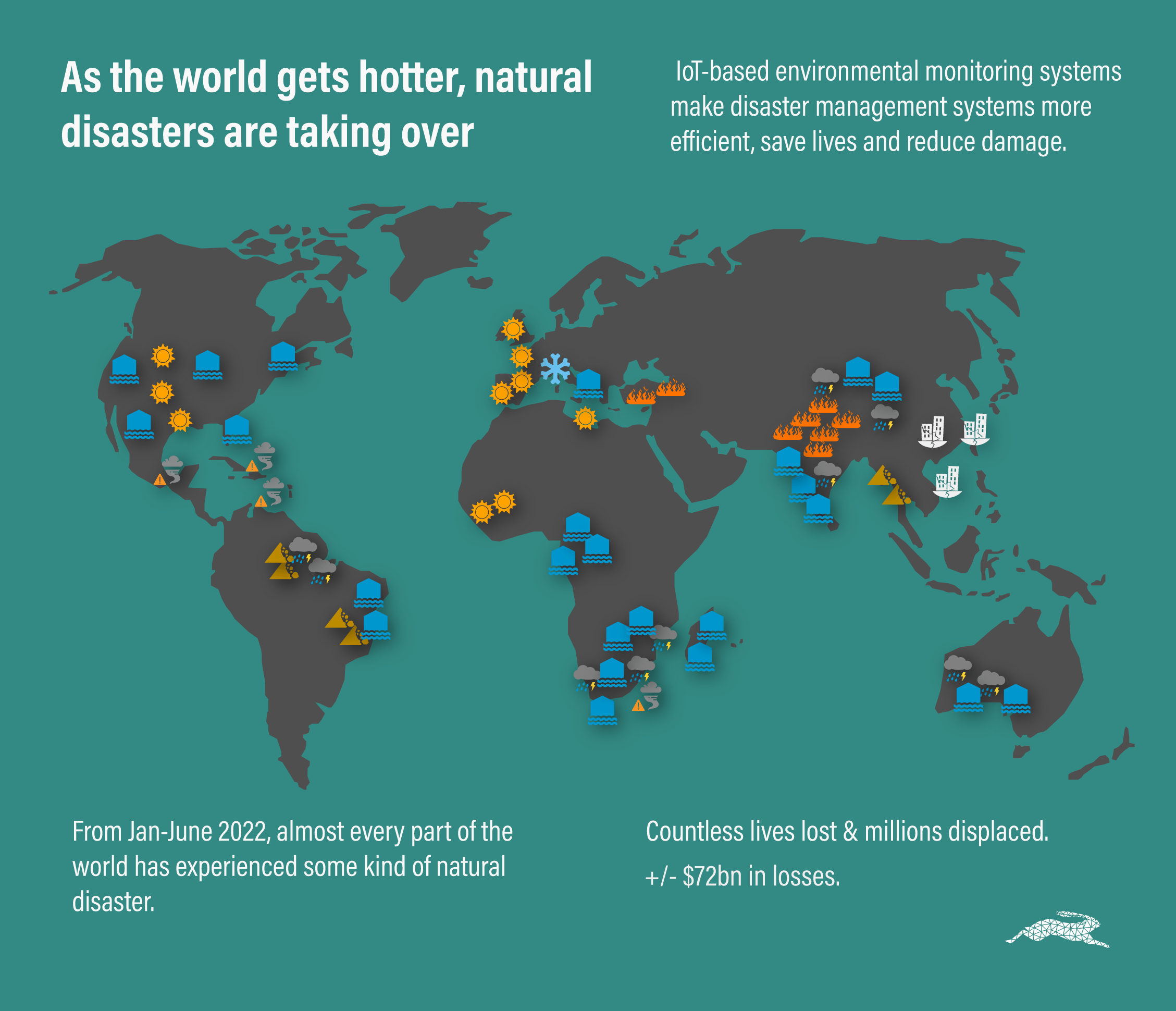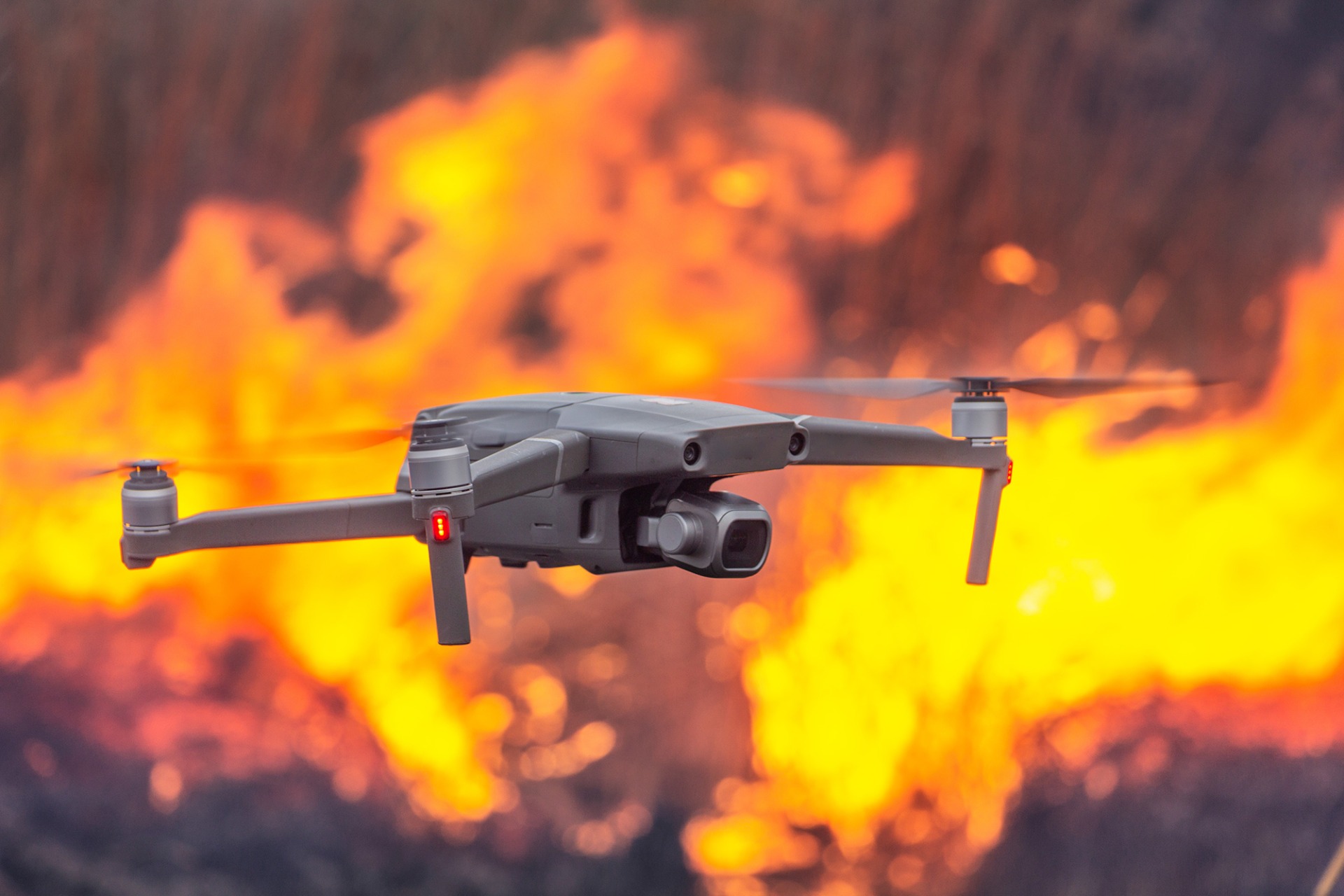Environmental monitoring and natural disaster management
Reading time 8.5 mins
Key Points
- Natural disasters dominated the world news for the first half of 2022, resulting in loss of lives, population displacement, ecosystem fragility, and economic disruption
- IoT and AI-based environmental monitoring systems can help to mitigate the impact by providing timeous alerts and helping to inform decision making
- Fire detection systems, flood forecasting initiatives, and hurricane alerts delivered in near real-time help to save lives and reduce property and environmental damage
- Technology has its limitations and these systems can make mistakes
- Public and private sectors need to engage more in all areas of climate responsibility and play an active role in ensuring the planet doesn’t get any hotter
Is your business ready to harness the potential of IoT? Our expert team can help design and implement bespoke IoT solutions. Reach out to us now to kick-start your IoT journey.
Ben Mazur
Managing Director
I hope you enjoy reading this post.
If you would like us to develop your next product for you, click here
With natural disasters dominating world news for the first half of 2022, it’s clear that robust environmental monitoring systems that can provide timeous alerts are needed. These weather-related catastrophes not only result in loss of lives and property damage, but they also destabilise ecosystems and economies.
That almost no part of the world remained unscathed is telling in itself. It’s debatable whether these increases in natural disasters are due to Climate Change or other factors (e.g. rapid urban development or agricultural expansion that make particular areas prone to flooding). Regardless of ‘the why’, Environmental Monitoring would still help to protect people and mitigate the damage these disasters cause.
What is Environmental Monitoring?
Environmental Monitoring refers to the tools and techniques designed to observe an environment, characterise its quality, and establish environmental parameters to accurately quantify the impact an activity has on an environment [1]. The information these monitoring systems provide helps to inform decision and policy making at various levels (i.e. international forums and private enterprises).
Over the past decade, only a few countries in Europe and Central Asia have been able to maintain environmental monitoring systems consistently [2]. They commonly focused on environments: air, water, waste management, biodiversity, remote sensing, and enterprises. Due to a lack of uniform methodologies across different areas, classification systems are often incompatible with international standards.
The primary function of these monitoring systems is to provide indices to base impact assessment reports on and inform future decisions. Which does little to predict where natural disasters might occur and alert people accordingly.
IoT and natural disaster management
Disaster risk management is generally organised around five stages: prevention, protection, preparedness, response, recovery, and review [3]. By bearing these in mind, decisions can be made to limit development in flood-prone areas, for example, and reduce vulnerable areas’ exposure when a natural disaster strikes.
Because IoT devices and sensors can collect data in real-time, extreme weather-related phenomena can be detected in their early phases and alerts sent to authorities quickly. As we highlighted in previous posts on Smart Forests, Biomimicry, and Cloud Seeding, IoT based applications have already proved how useful they can be for natural disaster detection and mitigation.
Vodafone piloted a wildfire detection system in Greece using cameras, AI, and environmental monitoring heat sensors. This system detects fires in their initial stages and sends alerts immediately.
Countries worldwide use FIRMS (fire detection and thermal anomaly technology developed by NASA) to mitigate the damage caused by wildfires. In South Africa, for example, they collaborated with the national electricity provider to develop a service to protect powerlines in remote areas and alert operators in the field about fire dangers in near real-time.
S2C technology created by Evologics (while still in its piloting phase) could potentially be used to detect underwater earthquakes and provide an early warning system for tsunamis.
In addition, there are regions in the Middle East and the USA where cloud seeding technologies are used to increase the chances of rain in response to prolonged periods of drought.
Can IoT predict weather-related disasters?
IoT solutions currently don’t have the power to prevent floods or hurricanes like they can to put out fires. Given the increasing frequency and severity of floods, there’s room for tech companies and innovative startups to leverage the potential of IoT to meet the various stages of disaster risk management more efficiently.
This is precisely what Google’s AI-based Flood Forecasting Initiative is doing:
- The initiative is part of their Crisis Response Program, helping people to access trusted information and resources in crises
- It’s currently being implemented and piloted throughout India and Bangladesh
- Data used for training the AI system is collected using rainfall records, monsoon patterns, and flood simulations
- They sent 115 million flood alerts in 2021
- Flood alerts are displayed on inundation maps so that people can easily visualise the depth of potential flooding
- Partnerships with humanitarian aid organisations help to alert people who don’t have internet or smartphones
Deploying environmental sensors to monitor water levels, wind, and tides is key to understanding the environment better. Combined with AI and Machine Learning (ML), collecting and creating datasets at the scale needed to make close-to-accurate predictions becomes possible.
As was done by Development Seed and their partnership with NASA to create a Deep Learning-Based Hurricane Intensity Estimator:
- The system uses weather satellite imagery to deliver live hurricane wind speed estimates
- It makes faster and more reliable forecasts of storm wind speeds
- This method can be up to six times faster than traditional techniques as hurricanes can be tracked every hour – instead of every six hours as is the case otherwise
- Authorities are in a better position to make decisions on whether to evacuate people and deploy resources where needed
Are tech-empowered environments enough to weather the storm?
The planet is getting hotter, and as a result, the hurricanes, wildfires, floods, and droughts that this triggers will increase in both frequency and intensity [4]. As much as environmental monitoring systems and IoT can help to predict where a natural disaster might strike, little can be done to prevent it once it’s in motion.
Granted, threats can be detected sooner, and people can be alerted to get out of harm’s way. Insurance policies can (hopefully) be modified to compensate for property loss and damage. Then, there’s the crucial role IoT has in post-disaster recovery efforts (e.g. search and rescue; using drones to deliver food and medical supplies). In addition, because IoT, AI, and ML are constantly evolving technologies, these monitoring systems will become increasingly robust and more efficient.
However, technology has its limitations.
AI can make mistakes.
IoT-based environmental monitoring devices can malfunction – especially when exposed to extreme weather variables.
We cannot rely on technology to pick up all of our slack. What happens if the international community, government bodies, the public and private sectors don’t actively engage in turning down the heat to become more climate responsible? Weather-based catastrophes will probably continue to increase in frequency and severity.
What are your thoughts on environmental monitoring?
Is IoT a viable solution for mitigating damage or merely a strategy that lulls us into a false sense of security?
Please send us a message if you find this as interesting as we do, and let’s co-create additional solutions!
- What is Environmental Monitoring? Definition and FAQs | HEAVY.AI. (n.d.). Retrieved September 8, 2022, from https://www.heavy.ai/technical-glossary/environmental-monitoring
- Environmental Monitoring | UNECE. (n.d.). Retrieved September 8, 2022, from https://unece.org/environmental-monitoring
- Crises and disaster management systems and plans. (n.d.). Climate-ADAPT. Retrieved September 8, 2022, from https://climate-adapt.eea.europa.eu/metadata/adaptation-options/crises-and-disaster-management-systems-and-plan
- Climate Change 2021: The Physical Science Basis. (n.d.). IPCC. Retrieved September 8, 2022, from https://www.ipcc.ch/report/ar6/wg1/
We love to talk about new ideas
Do you have an idea? Book a consultation with an expert - it's free, it's confidential and there are no obligations.
+44(0)117 329 3420
[email protected]
Ignitec Technology Centre
1 The Powerhouse
Great Park Road
Bradley Stoke
Bristol
BS32 4RU




